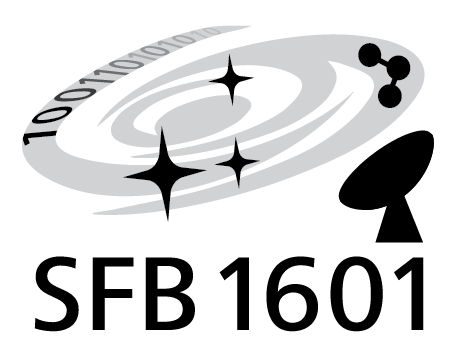Project leaders: Pfalzner, Susanne (FZJ); Walch-Gassner, Stefanie (PH1)

In A5, we will investigate the formation and evolution of massive stars and their associated star clus- ters on small scales (≲1-few pc). By means of combining state-of-the-art magneto-hydrodynamic (MHD) and N-body simulations, we will probe the full development cycle of (sub-)clusters hosting massive stars. We study the early formation phase of massive stars through to the stage at which the star formation process is locally completed and the remaining gas is unbound via stellar feed- back in the forms of ionizing and non-ionizing radiation and the associated radiation pressure as well as stellar outflows and winds. Supernovae can be included if the process takes more than a few million years. We will investigate whether the massive star habitat determines the fate of the final cluster, i.e. whether it remains bound or becomes unbound and forms an association. The long-term dynamical evolution will finally reveal in which habitats either short-lived or long-lived cluster preferentially form. The habitats we model and which set our initial and boundary conditions are inspired by the complementary observational projects within this CRC.
2025
Feedback and star formation efficiency in high-mass star-forming regions Journal Article
In: Monthly Notices of the RAS, vol. 544, no. 2, pp. 2136-2159, 2025.
In: MNRAS, vol. 534, no. 4, pp. 3321-3344, 2025.
Thermal emission from bow shocks III: Variable diffuse X-ray emission from stellar-wind bow shocks driven by dynamical instabilities Journal Article
In: Astronomy & Astrophysics, vol. 696, pp. A91, 2025.
ALMAGAL I. The ALMA evolutionary study of high-mass protocluster formation in the Galaxy. Presentation of the survey and early results Journal Article
In: Astronomy & Astrophysics, vol. 696, pp. A149, 2025.
Moving-mesh non-ideal magnetohydrodynamical simulations of the collapse of cloud cores to protostars Journal Article
In: Monthly Notices of the RAS, vol. 537, no. 1, pp. 379-401, 2025.
2024
Most nearby young star clusters formed in three massive complexes Journal Article
In: Nature, vol. 631, no. 8019, pp. 49-53, 2024.
References
- Dinnbier and Walch, “How fast do young star clusters expel their natal gas? Estimating the upper limit of the gas expulsion time-scale”, MNRAS 499, 748 (2020).
- Haid, Walch, Seifried, Wünsch, Dinnbier, and Naab, “SILCC-Zoom: The early impact of ionizing radia- tion on forming molecular clouds”, MNRAS 482, 4062 (2019).
- Pfalzner, “Universality of young cluster sequences”, A&A 498, L37 (2009).
- Pfalzner, Kirk, Sills, Urquhart, Kauffmann, Kuhn, Bhandare, and Menten, “Observational constraintson star cluster formation theory. I. The mass-radius relation”, A&A 586, A68 (2016).
- Pfalzner, Parmentier, Steinhausen, Vincke, and Menten, “The Evolutionary Tracks of Young MassiveStar Clusters”, ApJ 794, 147 (2014).
- Pfalzner and Kaczmarek, “The expansion of massive young star clusters – observation meets theory”,A&A 559, A38 (2013).
- Vincke and Pfalzner, “How Do Disks and Planetary Systems in High-mass Open Clusters Differ fromThose around Field Stars?”, ApJ 868, 1 (2018).
- Walch, Girichidis, Naab, Gatto, Glover, Wünsch, Klessen, Clark, et al., “The SILCC (SImulating theLifeCycle of molecular Clouds) project – I. Chemical evolution of the supernova-driven ISM”, MNRAS454, 238 (2015).
- Walch, Wünsch, Burkert, Glover, and Whitworth, “The Turbulent Fragmentation of the InterstellarMedium: The Impact of Metallicity on Global Star Formation”, ApJ 733, 47 (2011).
- Wünsch, Walch, Dinnbier, Seifried, Haid, Klepitko, Whitworth, and Palouš, “Tree-based solvers for adaptive mesh refinement code FLASH – II: radiation transport module TreeRay”, MNRAS 505, 3730(2021).
